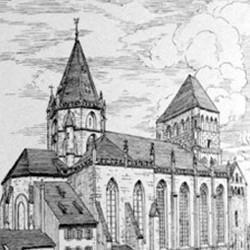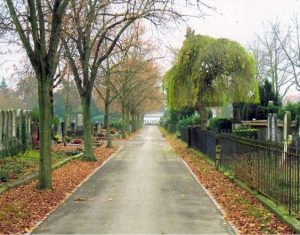Mulhouse was a town which had joined the Reformation Movement
In 1518, well-educated people started taking an interest in the writings of Luther. Zwingli transformed Zurich into a « truly Christian »town, while Oecolampade did the same for Bâle. The governing body of Strasburg allowed church services according to the new principles to be held alongside the traditional Catholic services.
In Mulhouse, the Magistrate decreed that a Christian was closely bound to the Word of God, which alone could give him true salvation and that priests should only teach how to understand the Holy Scriptures. 1523 can really be dated as the starting point of the Reformation in Mulhouse.
In 1526, the alliance with Switzerland was due for renewal – this took place every 5 years. But after a colloquy in Baden the Catholic Swiss Cantons refused to do so, as it had only been signed with the Protestant Cantons. The preacher called William Farel, from Neufchatel, who happened to be in Mulhouse at the time, encouraged the governing authority to keep trying and especially to preach Christian charity. However, even though Berne took radical measures such as abolishing the Mass, Mulhouse preferred to follow the example of Bâle – it only established the new reforms gradually : the main service had to begin with a hymn sung by all the congregation and end with the Lord’s Supper : Latin chants were not forbidden but had to be translated with a commentary beforehand. In 1529, under the influence of Bâle, a radical movement spread through Mulhouse : the Catholic Mass was abolished ; the last convents (or what remained of them) were closed ; works of art which were considered to be idols were removed, stored in a safe place or sometimes destroyed. In 1529, Mulhouse had become a truly Reformed town and remained so until it was attached to France in 1798.
Alliance with the Swiss Cantons
In 1529, Mulhouse, fearing interference from the powerful German empire, asked the Swiss for permission to enter the special alliance called the Christian Civic League, which the Reformed Cantons of Zurich and Berne had concluded in order to defend themselves against the Catholic Cantons which had support from Austria. When the conflict led to open warfare, Mulhouse sent in 100 soldiers to help them. The Canton of Zurich was defeated at the violent battle of Kappel (October 1531), where Zwingli lost his life. Sadly, with the ensuing treaty the Protestants lost all hope of ever seeing a Reformed Confederation, but the non-Catholic Cantons maintained their religious freedom.
From a religious point of view, the theologians in Mulhouse were in agreement , on the whole, with the Confederation in their ‘Confessio helvetica », which perpetrated the ideas of the deceased Zwingli. They also welcomed the ideas of Strasburg, who were supporting Bucer in his efforts to come closer to Luther. In 1556, Mulhouse joined the Reformed Cantons when they gave their support to the « Confessio helvetica posterior » ; an agreement drawn up by Bullinger – this theologian had eventually managed to come to an understanding with Calvin, a Protestant that was much closer to Luther than Zwingli.
Throughout the XVIth century, Mulhouse was strongly influenced by Bâle
Thanks to their alliance with the Swiss Cantons,Mulhouse was able to separate itself from religious conflicts in Germany where the Emperor Charles V was waging war against the ever-more powerful Lutheran heresy ; the religious treaty of Augsbourg (September 1555) put an end to these struggles and there was a renewal of Lutheranism in Germany. Mulhouse did well financially at this time. In France, the religious wars broke out and several days after the St Bartholemew Massacre the city welcomed the three young sons and the nephew of Admiral de Coligny. They were disguised as schoolchildren and went on later to Bâle and Geneva.
The end of the XVIth century was marked by internal disputes because the Catholics tried to regain power. In 1597, the Emperor Rodolph II claimed that the alliance with the Swiss was no longer valid and that the town had to become part of the Empire once more, together with all the obligations which ensued. He also declared that the city should be excluded from the renewal of the alliance of the Swiss Cantons with France. However the negociators from Mulhouse avoided this difficulty and managed to be joint signatories of the renewal of the treaty of the alliance of the Swiss Cantons with France, signed on the of 31st January 1602 in Paris.
Henry IV, through his ambassador in Prague, was able to make the Emperor understand that it was no use trying to annexe Mulhouse any more so in this way he was finally discouraged from doing so.
Mulhouse and the kingdom of France
With the treaty of Westphalia (1648) Alsace was annexed to France in progressive stages except for Mulhouse, which according to the same treaty maintained its independence.
When the Revocation of the Edict of Nantes was decreed in 1685, a great flood of refugees came into the city but it was not very safe so most families did not stay very long but went in secret to Switzerland. Louis XIV inspired fear into the Confederation and especially in Mulhouse, wedged in at the heart of the new French province whose administration from 1698 onwards was in Strasburg and whose judiciary capital was in Colmar. The fate of the little Republic depended on the attitude of the Swiss Cantons during the war of the League of Augsbourg (1686) and the war of succession in Spain (1701). The Cantons were still split by religious disputes but they did manage to maintain their neutrality in spite of much pressure and many unlawful attacks on their territory. During the various peace treaties, Mulhouse was always mentioned as being an ally of the Cantons. After the death of Louis XIV the treaties between the Confederation and the Kingdom of France had to be renewed. Unexpectedly the Swiss Cantons included Mulhouse in these negociations.
Mulhouse was a conservative town
Mulhouse was an independent and strictly Reformed city. Future pastors were trained in Bâle or Heidelberg. The population had to follow strict rules – they were not allowed to leave the town at the time of worship. A life of luxury was frowned upon : people had to dress simply and wedding celebrations were limited to 60 guests. No religious innovation was tolerated – Pietists and Moravians were sent into exile. No other form of religion was allowed and especially not Lutheranism, in contrast with Strasburg, where the Reformed act of Worship was accepted. The structure of schools underwent major reforms, but only concerning the teaching of religion. This was also in contrast with Strasburg, who set up their High School during the same year.
Mulhouse opened up to other beliefs
Mulhouse did well financially in the XVIIIth century as industrialisation began to develop.
The rational and analytical spirit of the Enlightenment had a positive effect on the city: its strict religious rules, the rigid social hierarchy of the bourgeoisie and the outdated administrative structures. Although the idea of religious tolerance was almost acceptable it took a long time to evolve and the Magistrate refused the Catholic order of worship outright. In the temple of St Stephen the preacher told his flock to obey the rules of civic morality and reminded them how lucky they were to live in a republic which gave them peace and freedom-(this would not have been the case if they had been governed by a selfish and brutal monarch) and declared how sad it was that people were less religious than before.
In 1657 public worship in French was introduced and the town allowed the French Calvinist community, which consisted of Huguenot families and a military garrison from Brisach to use the chancel of the Franciscan Church. A school for French-speaking children was opened in 1679. Little by little French Protestantism began to have an effect on the religious outlook of Switzerland and Alsace.
Mulhouse developed a new identity when it became reunited with France in 1798
The economic crisis which shook France in 1788 also affected Alsace. The winter of 1788-89 was particularly harsh – local craftsmen and major manufactories suffered badly as a result, although previously they had been successful; many people became unemployed and the price of corn rose. Alongside economic crisis, political unrest could be felt with the coming election of new municipalities by the parishes. However the bourgeois of Mulhouse had always been fervent republicans and they did not worry unduly: this had long been a democratic city and Church property had already been given to the people in the XVIth century.
This was not the case for the rest of Alsace which surrounded Mulhouse: it was overflowing with political unrest and revolutionary ideas swept inevitably into the city. The reforms of the Constituent Assembly (the governing body of revolutionary France) made it compulsory to have a common administrative structure throughout the country and this threatened to do away with the city’s customs barriers, much to the delight of their enemies and Colmar in particular. Mulhouse refused to use « assignations », which gave it a bad reputation, it was even rumoured that it harboured insubordinate priests and deserters. As Paris refused to let them establish a protective customs barrier, a blockade was set up which led to a rise in prices, especially of corn. Unemployment soured and workmen left the city. Although provisional transit was allowed, the city’s delegates realized that unless it was finally reunited with France, negociations would be fruitless. The Swiss Cantons showed no reaction. Many elements contributed to the fact that in January 1798 the Constitutional Assembly of the town decided on reunion with France (97 votes for and 5 against) : Reubell, from Colmar joined the revolutionary government (the Directory), the influence of southern Alsace, the open-mindedness of the bourgeoisie to revolutionary ideas and the enthusiasm of the younger generation.
One of the consequences of this reunion was that the city now opened its doors to Jews and Catholics. The town opened its doors to the Catholics, approximately 600, and he chancel of the Franciscan Church was given over to them which changed its name to St Mary’s Church.
Mulhouse, from the time of the Reformation until its union with France
mulhouse









